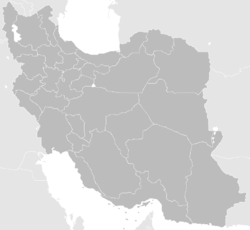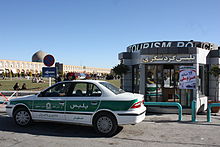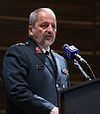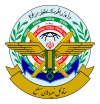Law Enforcement Command of the Islamic Republic of Iran
| Law Enforcement Command of the Islamic Republic of Iran فرماندهی انتظامی جمهوری اسلامی ایران Fərmândēhiy-ē Ēntēzâmiy-ē Jomhuriy-ē Ēslâmiy-ē Irân | |
|---|---|
 Official logo | |
 The official flag of the Law Enforcement Command of the Islamic Republic of Iran | |
| Common name | Iranian Police |
| Abbreviation | فراجا |
| Motto | كُونُواْ قَوَّامِينَ لِلّهِ شُهَدَاء بِالْقِسْط "Be steadfast witnesses for Allah in equity" [Quran 5:8] (Heraldry slogan) |
| Agency overview | |
| Formed | April 1, 1991 |
| Preceding agency |
|
| Employees | 360,000 (including conscripts and reserves)[1] |
| Jurisdictional structure | |
| National agency | Iran |
| Operations jurisdiction | Iran |
 | |
| Map of Iran with province borders | |
| Size | 1,648,195 km2 |
| Population | 86,758,304 (2022) |
| Constituting instrument |
|
| General nature | |
| Operational structure | |
| Minister responsible | |
| Agency executive |
|
| Parent agency | General Staff of the Armed Forces |
| Notables | |
| Anniversary |
|
| Website | |
| police | |
The Law Enforcement Command of the Islamic Republic of Iran,[a] previously known as the Law Enforcement Force of the Islamic Republic of Iran[4][5] or Disciplinary Force of the Islamic Republic of Iran,[6][7][b] abbreviated as Faraja (فراجا [fæɾɒːˈd͡ʒɒː]), is the uniformed police force in Iran. The force was created in early 1992 by merging the Shahrbani (شهربانی, Šahrbâni), Gendarmerie (ژاندارمری, Žândârmeri), and Islamic Revolutionary Committees (کمیته انقلاب اسلامی, Komite enghlâb-e eslâmi) into a single force.
It has more than 260,000 police personnel, including border guard personnel, and is under the direct control of the Supreme Leader Ali Khamenei who is the head of state and Commander-in-Chief of the Armed Forces.[8] In 2003, some 40000 women became the first female members of the police force since the 1979 Iranian Revolution.[9] The Guidance Patrol, commonly called the "morality police", is a vice squad/Islamic religious police in the Law Enforcement Force of the Islamic Republic of Iran, established in 2005 with the task of arresting people who violate the Islamic dress code, usually concerning the wearing by women of hijabs covering their hair.[10][11][12]
History
[edit]
The Persian Gendarmerie, also called the Government Gendarmerie (ژاندارمری دولتی), was the first modern highway patrol and rural police force in Persia. A paramilitary force, it also played a significant part in politics from its establishment in 1910 during the Qajar dynasty until the advent of the Pahlavi Iran in 1921. It was active for some time in the Pahlavi era. Nazmiyeh (نظمیه) was also a Law Enforcement force in Persia, with police duties inside cities.
Intensely concerned with matters of internal security in the post-1953 environment, Mohammad Reza Pahlavi authorized the development of one of the most extensive systems of law enforcement agencies in the developing world. The Imperial Iranian Gendarmerie (ژاندارمری شاهنشاهی ایران) and the National Police (Shahrbani شهربانی or Nazmiyeh نظمیه) gained in numbers and responsibilities. The secret police organization, SAVAK, gained special notoriety for its excessive zeal in "maintaining" internal security. But as in the regular armed forces, the shah's management style virtually eliminated all coordination among these agencies. He tended to shuffle army personnel back and forth between their ordinary duties and temporary positions in internal security agencies, in order to minimize the possibility of any organized coups against the throne. Added to this list of institutional shortcomings was the agencies' all-important public image, cloaked in mystery and fear.

After the 1979 Revolution, the gendarmerie, which was renamed to the Islamic Republic of Iran Gendarmerie (ژاندارمری جمهوری اسلامی ایران), numbered nearly 74,000 in 1979, and was subordinate to the Ministry of Interior. Its law enforcement responsibilities extended to all rural areas and to small towns and villages of fewer than 5,000 inhabitants. The International Institute for Strategic Studies estimated its manpower at 70,000 in 1986. The Gendarmerie was dissolved in 1990 and its personnel were assigned to the INP.
The National Police of Iran operated with approximately 200,000 men in 1979, a figure that has not fluctuated much since. The National Police was also under the Ministry of Interior, and its responsibilities included all cities with more than 5,000 in population, at least 20 percent of the population. Additionally, the National Police was responsible for passport and immigration procedures, issuance and control of citizens' identification cards, driver and vehicle licensing and registration, and railroad and airport policing. Some of these duties were absorbed into the Ministry of the Pasdaran during the early years of the Revolution, and cooperation between these two branches seemed extensive.
Since 1979, both these paramilitary organizations have undergone complete reorganizations. IRP leaders quickly appointed Gendarmerie and police officers loyal to the Revolution to revive and reorganize the two bodies under the Islamic Republic. Between 1979 and 1983, no fewer than seven officers were given top National Police portfolios. Colonel Khalil Samimi, appointed in 1983 by the influential Ali Akbar Nategh-Nouri, then Minister of Interior, who was credited with reorganizing the National Police according to the IRP's Islamic guidelines. The Gendarmerie followed a similar path. Seven appointments were made between 1979 and 1986, leading to a full reorganization. In addition to Brigadier General Ahmad Mohagheghi, the commander in the early republican period who was executed in late summer of 1980 and five colonels were purged. Colonel Ali Kuchekzadeh played a major role in reorganizing and strengthening the Gendarmerie after its near collapse in the early revolutionary period. The commander in 1987, Colonel Mohammad Sohrabi, had served in that position since February 1985 and was the first top officer to have risen from the ranks.
As of 1987, the National Police and the Gendarmerie reflected the ideology of the state. Despite their valuable internal security operations, the roles of both bodies were restricted by the rising influence of the Sepah and the Basij. The Gendarmerie was disbanded in 1991, along with the National Police and Islamic Revolution Committees; all three of these organizations being merged into the present-day Law Enforcement Force.

The Police–110 unit specializes in rapid-response activities in urban areas and dispersing gatherings deemed dangerous to public order. In 2003, some 400 women became the first female members of the police force since the 1978–79 Revolution.[13]
The current commander is IRGC-born Brigadier General Hossein Ashtari, former first deputy chief of police under Esmail Ahmadi Moqaddam; he relieved his predecessor and was appointed by the Supreme Leader Ayatollah Ali Khamenei on March 9, 2015.[citation needed]
Per a decree issued by Supreme Leader Ali Khamenei, on 8 December 2021 Law Enforcement Force structure was promoted to that of a General Command in 2021, it was thus renamed "Law Enforcement Command of Islamic Republic of Iran".[14][15]
Timeline
[edit]- In August 2024 Faraja ordered expelling of all unauthorized Afghan resident immigrants back to their country in one year.[16]
- In August 2024 a cctv was posted online it showed hijab Nour program police beating two teen girls badly on the street and taking them away.[17] In another incident police allegedly broke an Afghan girl's neck.[18]
Provincial Security Council
[edit]The Provincial Security Council is the highest provincial security body and is made up of the justice administration chief as well as the provincial police chief; it has the task to manage matters pertaining to security.[19] The council has a provincial jurisdiction charged of managing police issues, ranging from public security issues[20][21][22] to handling of serious criminal cases.[23]
Top organization
[edit]This article needs to be updated. (February 2024) |
All issues related to the Law Enforcement Force within the framework of the law are entrusted with the Interior Ministry; but in the areas of war, the authority lies with the Deputy Chief Commander of the Joint Forces.[24] Police top officers are directly appointed by the Supreme Leader. Law Enforcement Force also consists of several different provincial deputies. Provincial commanders rank between Colonel[25] and Brigadier General,[26] while provincial branch heads rank Colonel.
Branches
[edit]The Police-110 unit specializes in rapid-response activities in urban areas and dispersing gatherings deemed dangerous to public order. Marine police have 100 inshore patrols and 50 harbor boats.

The Law Enforcement Force of the Islamic Republic of Iran has a number of branches, each with specialized duties:
- The Iranian Public Conscription Organization (Persian: سازمان نظام وظیفه عمومی فراجا )
- The Prevention Police of FARAJA (Persian: پلیس پیشگیری فراجا), established in 2005;
- The Intelligence Organization FARAJA (SAFA for short; Persian: سازمان اطلاعات فراجا), established in 2022;
- The Public Security Police of FARAJA (Persian: پلیس امنیت عمومی فراجا)
- The Traffic Police of FARAJA (Rahvar for short; Persian: پلیس راهنمایی و رانندگی فراجا), established in 1991;
- The Cyber Police of FARAJA (FATA for short: Persian پلیس فضای تولید و تبادل اطلاعات فراجا, established in 2011, is Iran's Law Enforcement Force Cyber unit;
- The Anti-Narcotics Police of FARAJA (Persian: پلیس مبارزه با مواد مخدر فراجا), is an Anti-Narcotic unit;
- The Immigration & Passport Police of FARAJA (Persian: پلیس مهاجرت و گذرنامه فراجا) deals with issues of immigration and issuing passports to Iranian citizens;
- The Diplomatic Police of FARAJA (Persian: پلیس دیپلماتیک فراجا);
- The Criminal Investigation Police of FARAJA (Persian: پلیس اگاهی فراجا) Police Āgāhi of FARAJA, established in 1991;
- The Border Guard Command of FARAJA (Persian: فرماندهی مرزبانی فراجا), established in 2000, is Iran's border guard organization and its chief is Brigadier General Qasem Rezaee;[27]
- The Special Unit; it was involved in quelling of 2009 Iranian presidential election protests. It is responsible for suppressing riots, anti-terrorist activities, urban defence, and rescuing hostages. FARAJA special units include Anti-Terror Special Force ("NOPO" for short). According to a former commander, the Special Unit alone has 60,000 members across the country.[28][29]
- The Centre for Strategic Studies of the Iranian Law Enforcement Force, directed by Brigadier General Lotf-Ali Bakhtiari.[30]
Guidance Patrol
[edit]
The Guidance Patrol, widely known as the "morality police",[31] was a vice squad/Islamic religious police in the Law Enforcement Force of the Islamic Republic of Iran, established in 2005 and allegedly dissolved in 2022, with the task of arresting people who violated the Islamic dress code, usually concerning the wearing by women of hijabs covering their hair.[32] On December 3, 2022, the Attorney General of Iran, Mohammad Jafar Montazeri, said in Qom that the police guidance patrol is not under the supervision of the judiciary system and it is closed now from where it was begun first.[clarification needed]
Branch seals
[edit]-
Criminal Investigation Police
-
Economic Security Police
-
Prevention Police
-
Traffic Police
-
Special Unit
-
Cyber Police
-
Border Police
-
University of the Law Enforcement Force
-
Public Security Police
-
Social Affairs Deputy
-
Rescue and Healthcare Deputy
Budget
[edit]Ghavamin Bank was financed by the police pension fund. It controls FARAJA Cooperation Bonyad.
Chiefs of Law Enforcement Force
[edit]| No. | Portrait | Commander-in-Chief | Took office | Left office | Time in office | Previous service |
|---|---|---|---|---|---|---|
| 1 | Brigadier general Mohammad Sohrabi | 1 April 1991 | 24 September 1992 | 1 year | Gendarmerie | |
| 2 | Brigadier general Reza Seifollahi | 24 September 1992 | 15 February 1997 | 4 years | Islamic Revolutionary Guard Corps | |
| 3 | Brigadier general Hedayat Lotfian | 15 February 1997 | 27 June 2000 | 3 years | Islamic Revolutionary Guard Corps | |
| 4 | Brigadier general Mohammad Bagher Ghalibaf (born 23 August 1961) | 27 June 2000 | 4 April 2005 | 4 years | Islamic Revolutionary Guard Corps | |
| - | Brigadier general Ali Abdollahi Acting | 4 April 2005 | 9 July 2005 | 2 months | Islamic Revolutionary Guard Corps | |
| 5 | Brigadier general Esmail Ahmadi-Moghaddam (born 1961) | 9 July 2005 | 9 March 2015 | 9 years, 9 months | Islamic Revolutionary Guard Corps | |
| 6 | Brigadier general Hossein Ashtari (born 1959) | 9 March 2015 | 9 January 2023 | 7 years, 10 months | Islamic Revolutionary Guard Corps | |
| 7 | Brigadier general Ahmad-Reza Radan (born 1963) | 9 January 2023 | 2 years, 4 days | Islamic Revolutionary Guard Corps |
Equipment
[edit]Weapons
[edit]- Heckler & Koch MP5
- SIG Sauer P220
- SIG Sauer P226
- Heckler & Koch HK21
- Smith & Wesson Model 10
- Dragunov
- Electroshock weapon
- AK-47
- Uzi
- FIM-92 Stinger
- Remington 870
- PK machine gun
- M79 grenade launcher
- DShK
Cars
[edit]- Samand
- Mercedes-Benz C 240
- Mercedes-Benz E 240
- Nissan Xterra N50
- Toyota Land Cruiser 100 Series[broken anchor]
- Renault Mégane
- Mitsubishi Pajero
- Toyota Hilux Sixth generation and Seventh generation
- Volkswagen Transporter
- Kia Forte TD
- Hyundai Santa Fe DM
- Nissan Teana
- Suzuki Grand Vitara
- Toyota Corolla E150
- Citroën Xantia
- Peugeot 207
- Peugeot 405
- Peugeot 206
- Formerly used cars
Motorcycles
[edit]Aircraft
[edit]See also
[edit]Notes
[edit]References
[edit]- ^ فعالیت ٥٠٠هزار نفر از پرسنل نيروي انتظامي برای تامین امنيت ايام نوروز (in Persian). Mehr News Agency. 27 March 2014. Archived from the original on 19 April 2015. Retrieved 10 March 2015.
- ^ a b "Leader appoints Ashtari as new police chief". Tehran Times. Archived from the original on 11 March 2015. Retrieved 10 March 2015.
{{cite news}}: CS1 maint: bot: original URL status unknown (link) - ^ روز نیروی انتظامی (in Persian). Archived from the original on 19 April 2015. Retrieved 10 March 2015.
- ^ "Police Chief stresses law enforcement forces' good conditions". Archived from the original on 2018-01-12. Retrieved 2014-11-29.
- ^ "Photos: Photos: Iranian Police Forces". Archived from the original on 2 May 2015. Retrieved 21 July 2015.
- ^ Mohammadi, Majid (13 May 2013). Judicial Reform and Reorganization in 20th Century Iran. Routledge. ISBN 9781135893422. Archived from the original on 18 December 2020. Retrieved 22 October 2014.
- ^ "Supreme Leader's Remarks on the Day of Disciplinary Forces". English.irib.ir. Archived from the original on 23 October 2014. Retrieved 22 October 2014.
- ^ "Archived copy" (PDF). Archived (PDF) from the original on 2009-06-12. Retrieved 2008-07-14.
{{cite web}}: CS1 maint: archived copy as title (link) - ^ Text used in this cited section originally came from: Iran (March 2006) profile Archived 2012-01-30 at the Wayback Machine from the Library of Congress Country Studies project.
- ^ "UNICEF Iran (Islamic Republic of) – Media centre – Statement by Paul Hulshoff, UNICEF Iran Representative at the opening session of the Seminar on "Police and Justice for Children"". Archived from the original on 23 October 2014. Retrieved 21 July 2015.
- ^ "Department of Treasury and State Announce Sanctions of Iranian Security Forces for Human Rights Abuses". U.S. Department of State. Archived from the original on 4 July 2019. Retrieved 21 July 2015.
- ^ "The World Factbook". Archived from the original on 10 January 2021. Retrieved 21 July 2015.
- ^ "COUNTRY PROFILE: IRAN" (PDF). Lcweb2.loc.gov. May 2008. Archived (PDF) from the original on 30 January 2012. Retrieved 22 October 2014.
- ^ "رونمایی از طرح سازمان فرماندهی انتظامی جمهوری اسلامی ایران- اخبار پلیس - اخبار اجتماعی تسنیم | Tasnim". Archived from the original on 2021-12-09. Retrieved 2021-12-09.
- ^ "Iran's Law Enforcement Shuffle Reflects Concern About Protests". The Washington Institute. Retrieved 2022-07-24.
- ^ فردا, رادیو (7 August 2024). "فرمانده نیروی انتظامی ایران: اتباع غیرمجاز باید تا پایان سال به کشور خود بازگردند". رادیو فردا.
- ^ "خشونت مجریان "طرح نور" علیه دو دختر؛ "پزشکیان پاسخ دهد" – Dw – ۱۴۰۳/۵/۱۷".
- ^ "Iranian police break neck of Afghan teen amid deportation crackdown". 8 August 2024.
- ^ "Tehran officials raise against public flogging". Payvand Iran News. 8 August 2001. Archived from the original on 24 April 2015. Retrieved 21 April 2015.
- ^ "Film community rallies for Afghan immigrants". Radio Zamaneh. 1 May 2012. Archived from the original on 24 April 2015. Retrieved 21 April 2015.
- ^ "Iran Report: June 16, 2003". Radio Free Europe. 16 June 2003. Archived from the original on 25 April 2015. Retrieved 21 April 2015.
- ^ "IRAN: ANNUAL SURVEY OF VIOLATIONS OF TRADE UNION RIGHTS (2005)". tavaana.org. Archived from the original on 18 May 2015. Retrieved 21 April 2015.
- ^ "3 Tourists Kidnapped in Iran Are Released". Los Angeles Times. 29 December 2003. Archived from the original on 25 April 2015. Retrieved 21 April 2015.
- ^ Fulfilling Promises: A Human Rights Roadmap for Iran's New President (PDF). International Campaign for Human Rights in Iran. 2013. p. 31. Archived (PDF) from the original on 24 September 2015. Retrieved 19 April 2015.
- ^ "18 terrorists in southern Iran say they get money for operations". Islamic Republic News Agency. 14 January 2015. Archived from the original on 27 April 2015. Retrieved 20 April 2015.
- ^ "Commander Underlines Full Security at Iran's Eastern Borders". Farsanews. 26 October 2014. Archived from the original on 27 April 2015. Retrieved 20 April 2015.
- ^ Niayesh, Umid (27 October 2014). "Iran, Iraq discuss cooperation on border security". Trend. Archived from the original on 17 April 2015. Retrieved 17 April 2015.
- ^ "Iranian police commander concedes mistakes in 2009 protests". al-Monitor. 2 September 2014. Archived from the original on 13 April 2015. Retrieved 7 April 2015.
- ^ "Iran police showcase latest anti-riot capabilities". Ashraq al-Awast. 10 October 2014. Archived from the original on 12 April 2015. Retrieved 8 April 2015.
- ^ "Iran, Iraq to Boost Police Cooperation in Near Future: Police Official". Tasnim News Agency. 18 January 2015. Archived from the original on 24 September 2015. Retrieved 20 April 2015.
- ^ Ghaedi, Monir (23 September 2022). "Iran's 'morality police:' What do they enforce?". DW.com. Retrieved 25 September 2022.
"Gasht-e-Ershad," which translates as "guidance patrols" and is widely known as the "morality police," was a unit of Iran's police forces tasked with enforcing the laws on Islamic dress code in public.
- ^ Sharafedin, Bozorgmehr (20 April 2016). "Rouhani clashes with Iranian police over undercover hijab agents". Reuters. Retrieved 12 August 2016.
Sources
[edit] This article incorporates text from this source, which is in the public domain. Country Studies. Federal Research Division.
This article incorporates text from this source, which is in the public domain. Country Studies. Federal Research Division.


















